The work is devoted to consideration of possible ways to protect nature. Nature is our wealth: it is our task and duty to preserve this wealth for future generations.
The object of the study — environment.
The purpose of the work is to draw the attention of children and adults to the problem of pollution and to promote the formation of an environmental culture.
The tasks which I have put in front of me in the research:
- Gather all the actual information about the state of nature at the moment
- Find methods that will work more effectively
- Collect analytics in the field of environmental issues
In order to solve these tasks, I have used such methods :
– Description
– Syntactic and semantic analyses
– Comparison
– Analytics
What is happening to the environment now?
The environment affects the lives of people and the development of society as a whole. As a consequence, people, progress, development and the environment are closely linked.
The environment can also pose a threat. Contaminated air, waterborne infections, toxic chemicals, and natural disasters are only some of the threats to humanity that the environment poses.
In many countries, the pollution of natural resources, land, water and forests> is occurring at an alarming rate, and if all this disappears, it will disappear forever.
If we want development to be sustainable, i.e., to meet today's needs without endangering the possibilities of future generations, countries must care not only about economic progress but also about protecting the environment.
In the fight against poverty, one of the important aspects is to take care of the environment worldwide, since the poorest people live in the most vulnerable regions.
In past centuries, when the number of earthlings was small and industry was poorly developed, man rarely thought about the consequences of gross interference in nature. And gradually, with the development of scientific and technological progress, the attack on nature led to the depletion of soils, the shallowing of rivers and lakes, the death of vegetation, the formation of deserts. In recent years, the ecological situation has deteriorated sharply, many species of plants and animals are disappearing and becoming rare, and many corners of nature are losing their value. Many people began to worry about worsening of ecological situation on the Earth. And then they began to create the whole areas in the world, in which they began to protect the whole natural components, including ours in Russia. In 1916 on the 11th of January the first Barguzinsky wildlife reserve was established in the history of the Russian state. Today in Russia there are already 100 reserves, 35 national parks, and 68 zakaznik.
Almost a million years mankind has been living on planet Earth, but at present people give little thought to the fact that all the earth's riches are not eternal, that they need protection, replenishment and careful treatment.
What consequences await us?
Greenhouse gases, such as fossil fuels emitted by vehicles and factories and methane emitted by livestock, contribute to air pollution and exacerbate climate change by raising the earth's temperature. In this case, climate change is exacerbating a particular type of air pollution.
The reaction between emissions from burning fossil fuels and sunlight creates smog. Climate change also creates air pollutants such as mold caused by humidity and pollen caused by a longer pollen season and increased pollen production.
Air pollution can have serious effects on human health. If you are exposed to very high levels of air pollution, you may experience eye, nose and throat irritation, wheezing, coughing and breathing problems, and a greater risk of heart attacks.
Air pollution can also exacerbate existing lung and heart conditions, such as asthma. Smog can irritate the eyes and throat and damage the lungs. Children, the elderly, and people who work or play sports outdoors are at greater risk. People with asthma or allergies are most at risk, as pollutants can worsen their symptoms and trigger asthma attacks.
Around the world, climate change is causing increased droughts, heat waves, storms, warming oceans, and rising sea levels that are affecting animal species, destroying their natural habitat.
Pollutants in the soil from industrial sources, deforestation, and improper waste disposal endanger animals and plants. Soil contaminated with chemicals eventually becomes infertile and unable to support crops and other plant life. This hinders food production and can lead to starvation. If soil contaminants contaminate food, anyone who eats it can get sick. Toxic soil can also cause illness through skin contact or inhalation.
Pollutants in water from garbage disposal, oil spills, sewage, and runoff from agricultural fields, construction sites, and factories affect native plant and animal species. When water poisoning occurs, many animals die.
Animals are also often injured or killed by solid waste discharged into the water. Drinking water contamination caused by sewage spills can cause illness and digestive problems in humans. Contaminants such as mercury in fish and seafood can cause serious health problems, especially in children and pregnant women.
Noise is considered an environmental pollutant caused by household sources, public events, commercial and industrial activities, and transportation.
Light pollution is caused by prolonged and excessive use of artificial light at night, which can cause health problems for people and disrupt natural cycles, including wildlife activities. Sources of light pollution include electronic billboards, nighttime sports fields, street and car lights, city parks, public spaces, airports and residential areas.
According to the scientist V. I. Vernadsky, the only correct approach to the biosphere is as an integral global ecological system with a definite structure and stability, inherent features of its formation and development. Such an understanding of the biosphere is especially important now, when man's technogenic impact on nature has reached unprecedented proportions and is capable of causing planetary changes in the human habitat.
Nitrogen oxides, sulfur oxides and acids precipitated by rain and snow cause irreparable damage to forests and reservoirs; thousands of lakes in Canada, the United States and Northern Europe have been acidified in recent decades. Forests are dying out rapidly in almost all European countries because of atmospheric pollution and acid rain. The forests in Germany, Great Britain and Czech Republic are severely damaged 71 % of the forests. These forests are dying out, but along with the forest, all the fauna and flora associated with it are dying out. (Pearson R., 1969) The green cover of the planet is decreasing mainly because of intensive logging, clearing forest areas for agriculture, fires, and, of course, as a result of environmental pollution.
How people struggle with these problems?
The most affected groups are vulnerable populations, namely women, children, minorities, indigenous peoples, and the poor. Women and girls in poor countries, for example, often use coal and kerosene for cooking and heating, which pollute the air. Because children's brains and bodies are highly susceptible to toxic substances during development, childhood exposure can cause chronic health problems.
Major sources of air pollution (power plants, factories, incinerators, and busy highways) are often located in impoverished areas. Poverty is an additional risk factor also because residents who breathe dirty air are not always able to see a doctor, and are often unaware of its effects. Since 1990, wealthy, less polluted countries (e.g., the United States, EU member states, and Japan) have seen improvements in air quality, while a number of highly polluted countries (Bangladesh, India, and Pakistan) have seen their air quality worsen.
The UN expert noted that air pollution causes respiratory, infectious and heart disease, stroke, lung cancer and pregnancy-related complications. Children who inhale dirty air are increasingly susceptible to asthma, chronic lung disease, stunted growth, diabetes, childhood obesity and mental retardation.
David Boyd called air pollution an «invisible killer» that kills 800 people every hour, many of whom have endured long, painful illnesses such as cancer, respiratory or heart disease. At the same time, the Special Rapporteur laments, the problem receives little attention, unlike, for example, natural disasters — even though more than 150 nations, by acceding to international treaties and enacting relevant laws, have pledged to respect and protect the right to a healthy environment.
«People can't avoid dirty air — either in their homes or outside their homes», David Boyd said. — It permeates everywhere».
The main causes of air pollution are power generation, industrial processes, mining, agricultural activities, unsustainable waste management and transportation. It is estimated that the total cost of air pollution exceeds $5 trillion per year.
International organizations have repeatedly raised concerns about open burning in Lebanon, bauxite mining in Guinea, and coal mining in Mozambique. If we are all to breathe clean air, local, national, and most importantly, international action will be needed, because much of the air pollution is of transboundary origin, that is, its sources are in another country. A quarter of premature deaths due to air pollution are related to international trade, that is, the production of goods for export from low-income countries to wealthy countries. In China, for example, inadequate conditions for producing goods for the West, result in 100,000 deaths annually.
Unless effective measures are taken immediately, deaths from air pollution will increase by 50 to 100 percent by 2050.
Which countries are doing what?
- USA
– Cutting carbon emissions by nearly a third
Ahead of the December 2015 United Nations Climate Change Conference in Paris, the Obama administration unveiled regulations to implement major cuts in U. S. carbon emissions.
– Exercising leadership with other major economies
President Obama and Chinese President Xi Jinping signed a historic agreement to fight climate change. America and China, the world's two largest economies, have jointly announced plans to combat the global threat of climate change.
– Redesigning cities to make them «greener»
Cities like New York City, Los Angeles, and Portland, Oregon, are finding clever ways to «go green». Cities are offering local solutions by rethinking transportation, updating building codes, and promoting renewable energy.
– Investing billions in clean energy
The U. S. is investing in renewable energy: the country has tripled its use of wind power since 2008, and more than ten times its solar energy production.
– Taking action in the private sector
The U. S. company Alcoa sponsored a tree planting event in Bohai, China. (Alcoa).
Major U. S. corporations, including Google, Apple, and Walmart, are taking the American Companies Climate Action Commitment and making responsible environmental policies a priority.
– Raising fuel economy standards for cars and trucks
New regulations to reduce transportation emissions from cars and trucks will reduce billions of tons of greenhouse gases each year.
– Carbon Neutralization
Technology at the Petra Nova carbon neutralization facility in Texas is making energy production cleaner, safer and more sustainable. Technology that captures pollutants in factories and keeps them underground has already removed the equivalent of two million cars' annual emissions.
- Russia
– Russia is one of the world's leading oil producers and ranks fourth among the top «polluters» of the atmosphere. According to foreign experts, until recently, the country has responded little to international pressure to take part in the fight against global warming. Putin has not commented on the climate risks associated with rising temperatures, and agencies have taken no concrete action, despite the fact that the country joined the Paris climate agreement two years ago [21].
– In June 2021, however, Putin ordered a strategy to reduce Russia's carbon footprint. On a direct line at the end of the month, the president expressed great concern about climate change and its consequences for Russia. He noted that much of the country is covered by «permafrost», and if the soil begins to melt, Russia will face serious economic consequences.
– In July, Putin signed a law limiting greenhouse gas emissions, laying the groundwork for «green» projects and the development of carbon trading. At the end of September, the government finalized its climate strategy: 34 billion rubles will be allocated to combat global warming until 2030.
– Russia accounts for about five percent of global carbon emissions released into the atmosphere each year. Almost 90 percent of all energy consumed in the country is produced from «dirty» resources — fossil fuels. This figure is 10 percent higher than the global average. Moreover, Russia has an economic incentive to make an energy transition — according to Bloomberg, accelerated deployment of renewable energy sources would save the country up to $11 billion annually over the next 20 years.
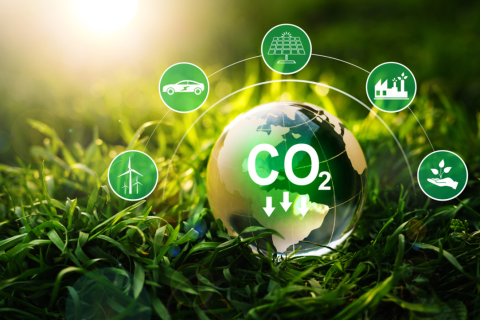
- China
– The goals of reducing carbon emissions, improving energy conservation and energy efficiency will be deeply integrated into national legislation and development plans. For example, provisions that contradict the carbon footprint and carbon neutrality will be eliminated from all PRC laws. Low-carbon development standards will be enshrined in regional strategies, as well as in sectoral plans for energy, transport, metallurgy, construction, petrochemical and other industries. The political stance on «strict containment of uncontrolled expansion of energy-intensive projects with high emission levels» has been confirmed. Mandatory energy efficiency standards for equipment and household appliances will be raised.
– Systems of support for reducing the carbon footprint are being actively created across the country. An important step in this direction was the launch of a nationwide carbon trading system on July 16, 2021. They are a system of redistribution of the right to emit carbon dioxide from companies whose emissions are below the ceiling set by the state, to enterprises that exceed the maximum limits of emissions. The PRC carbon market has immediately become the largest in the world, covering 4.5 billion tons of carbon emissions in its initial phase alone. The bidding system today includes 2162 electricity generating companies. Later the market will expand: petrochemical and chemical companies, producers of building materials, steel, non-ferrous metals and paper, as well as airlines will be included.
– In the near future, China will publish a list of 100 industrial parks and cities that will be tasked to pass the peak of carbon emissions before the year 2030 as outlined in the Roadmap. For this they will be provided with all possible financial, political and technological support.
– The emphasis in reducing the carbon footprint is primarily on reducing the share of coal in the national energy system and increasing the role of non-fossil energy sources. From 2005 to 2020, the PRC has already reduced the share of coal in the national energy supply from 72.4 percent to 56.8 percent. As a result, between 2015 and 2020 alone, the amount of PM2.5 harmful aerosols in the air of Chinese cities decreased by an average of 28.8 percent. It is confirmed that during the XIVth Five-Year Plan (2021–2025), the country will «restrain» the growth of coal consumption as much as possible, and from the XVth Five-Year Plan (2025–2030) will begin a «gradual reduction» of solid fuel use.
– At the same time the volume of installed capacity at solar and wind power plants is growing rapidly. From 2005 to 2020, it increased 3,000-fold at photovoltaic plants and 200-fold at wind farms. Today, China provides 15.9 percent of its national energy consumption from non-fossil energy sources. That figure is scheduled to rise to 20 percent by 2025, and to 25 percent by 2030. This will reduce the country's carbon dioxide emissions by 65 percent by 2030 compared to 2005. By 2060, non-fossil energy sources will account for more than 80 percent of China's energy consumption [22].
– The new «climate» documents also focus on the development of a network of carbon sinks — artificial or natural systems that soak up carbon dioxide from the air. A course to improve the carbon sequestration capacity of such systems is outlined. In particular, the bet is on the expansion of forest plantations. In 1980s, only 12 % of the area of China was covered by forests, now this figure has been brought up to 23 %, by 2025 it will be increased to 24.1 %, and by 2030 — to 25 %.
– Separately, the documents outline the development of low-carbon transport and energy-efficient buildings. In particular, by 2025 half of the roofs of new buildings will be covered with solar panels to supply homes with electricity and hot water. By 2030, new energy-powered cars will account for 40 percent of sales in the PRC car market, and by the same year, peak oil consumption in transportation will be passed.
– International cooperation in combating climate change and building a low-carbon economy has not been ignored. Beijing is convinced that the two countries should work in unison: no one will be able to cope with climate challenges alone and the policy of self-isolation and unilateral actions will not give any results.
– China has guaranteed that it will contribute to the fight against climate change as much as it can. Thus, in September 2021, Chinese President Xi Jinping announced that China will curtail construction of coal-fired power plants abroad and will help developing countries to develop green energy. At the same time, a «Green Silk Road» program is being developed, under which low-carbon energy will be promoted in the member countries of the «One Belt, One Road» integration initiative.

- Singapore
– The 2015 Paris Agreement sets a global framework for limiting global warming to well below 2°C, preferably to 1.5°C (degrees Celsius), compared to pre-industrial levels. To achieve this global temperature goal, countries seek to reduce the growth of greenhouse gas emissions as quickly as possible, and then rapidly reduce them based on the best available science, economic, and social feasibility.
– The effects of climate change are already clearly visible in rising air temperatures, melting glaciers and shrinking polar ice caps, rising sea levels, increased desertification, and more frequent extreme weather events such as heat waves, droughts, floods, and storms. Climate change is not globally uniform and affects some regions more than others. In the following charts, you can see how climate change has affected the Singapore region over the past 40 years. The data source is ERA5, ECMWF's fifth-generation atmospheric reanalysis of global climate, covering the time range from 1979 to 2021 with a spatial resolution of 30 km.
– The data will not show conditions at the exact location. Microclimates and local differences are not shown. Therefore, temperatures will often be higher than shown on the screen, especially in urban areas, and precipitation may vary depending on the topography.
– Singapore has announced a dramatic increase in the price that polluters must pay for carbon emissions. The move is aimed at allowing the city-state, a major Asian oil refining and petrochemical center, to reach its goal of zero emissions by 2050.
– The tax increase will be gradual. By 2024, it should be $18.6 and by 2030 -- $37 to $60, while today Singapore's tax is one of the lowest in the world for carbon pollution [23].
– Eco-Business reports that Singapore Finance Minister Lawrence Wong announced the tax hike during the annual national budget session in Parliament, warning that government spending on reducing carbon emissions would be high for a country with limited renewable energy potential. Wong said revenue from the tax will still be used to invest in green technology.
– «In the next decade, we expect the greening of traditional sectors of our economy, such as aviation, energy and tourism. At the same time, new green sectors will become increasingly important», the minister clarified.
– Ajay Kumar Sanganeria, head of tax consultancy KPMG Singapore, said the carbon tax increase is «not surprising» given the government's 10-year environmental plan announced last year. «What's good is that this change is being phased in, giving businesses enough time to adapt and decarbonize, minimizing the impact on their business», he said.
– Energy bills for four-room public apartments are expected to increase by about 4.5 percent. At the same time, the government has promised subsidies for low-income people.
– It is not yet known whether the criteria for those who pay the tax is changing. At present it is imposed on facilities that emit more than 25 thousand tons of carbon dioxide per year. The organizations that pay the carbon tax have not been disclosed, but the government has said that about 50 facilities in the industrial, energy and waste sectors create 80 percent of the emissions. In a parliamentary proposal last month, politicians asked for more coverage of the carbon tax to include those who emit 2,000 tons of carbon a year. There are about 200 such facilities in Singapore.
– But the $60 cap is still below the $100 estimate suggested by various think tanks for keeping global warming in check. Wood Mackenzie, an international consulting firm, estimated that carbon prices would have to reach $160 a ton by 2030 to keep global warming below 1.5°C, a goal that scientists say would help avoid the worst effects of climate change.
– «We aim to put Singapore at the forefront of green technology, where new innovations are developed, tested, scaled and eventually exported to the rest of the world. We will work hard to gain a first mover advantage», said Wong.
What does it take to protect nature? Effective methods.
- Study and obey environmental laws. Observe and follow the rules of conduct in nature.
- To draw schoolchildren's attention to environmental problems.
- To conduct environmental actions and create environmental trails.
- To hold events instilling a careful attitude towards nature.
- To plant trees, bushes and flowers. 6.
- To help wintering birds and meet migrating birds.
- To make hikes and excursions to the wildlife.
- To take care of the forest and to follow the rules of conduct in the forest.
- To hold ecological festivals.
- To learn to love, protect and conserve everything around us.
Analytical part
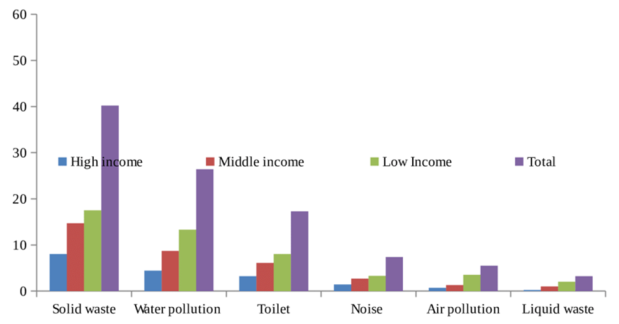
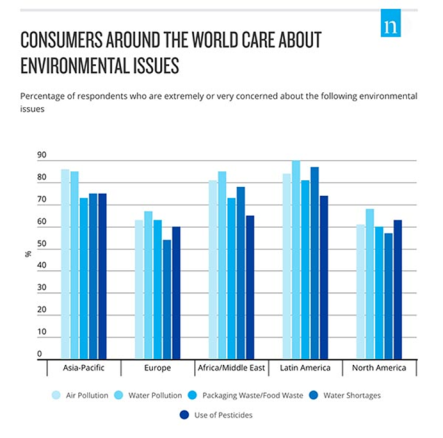
[https://whattheythink.com/articles/93586-study-environmental-issues-matter-more-ever/]
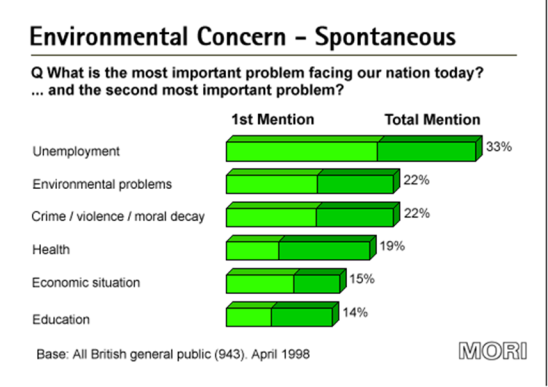
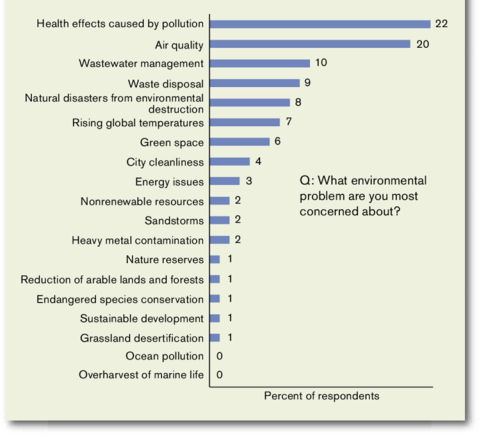
Glossary
- Abiotic Resources
Resources which are considered abiotic and therefore not renewable. Zinc ore and crude oil are examples of abiotic resources.
- Ancillary Material
Material that is not used directly in the formation of a product or service.
- Auditing
See environmental management system audit.
- Biotic Resources
Resources which are considered biotic and therefore renewable. The rainforests and tigers are examples of biotic resources.
- By-Product
A useful and marketable product or service that is not the primary product or service being produced. See also co-product.
- Certification
The procedure by which third party gives written assurance that a product, process, or service conforms to specific requirements. See also registration.
- Characterization
Characterization aggregates classified environmental interventions/aspects within an environmental impact category. This step results in environmental performance indicators.
- Characterization Factor
A factor that describes the relative harmfulness of an environmental intervention within one environmental impact category. A factor is a result of modeling environmental effects/problems.
- Classification
Classification attributes are environmental interventions/aspects listed in environmental inventory/environmental effects register according to environmental impact categories.
- Close-loop Recycling
A recycling system in which a product made from one type of material is recycled into a different type of product (e.g. used newspapers into toilet paper). The product receiving recycled material itself may or may not be recycled. See also open-loop recycling.
- Co-Product
A marketable by-product from a process that can technically not be avoided. This includes materials that may be traditionally defined as waste such as industrial scrap that is subsequently used as a raw material in a different manufacturing process.
Conclusion
Every step to preserve nature is an indicator of our love for our homeland. And such steps are within the power of all people. It can be a variety of actions: to save a meadow flower, save the forest from fire, not to ruin birds' nests, correctly collect mushrooms and medicinal herbs, simply do not throw garbage wherever, thus we will save and preserve our nature, and therefore the Motherland.
And the hypothesis during the project is confirmed: everyone can make a feasible contribution to the preservation of nature and Motherland.
My project — it is that voice, which calls you all in need from childhood to create a favorable living space around you, learn to plant trees, flowers, observe the rules of conduct in nature, in one word, to understand and love the world around us, and therefore to protect the nature of our native land — Motherland.
Healthy ecosystems clean our water, purify our air, maintain our soil, regulate the climate, recycle nutrients and provide us with food. They provide raw materials and resources for medicines and other purposes. They are at the foundation of all civilization and sustain our economies.
Biodiversity is the key indicator of the health of an ecosystem. A wide variety of species will cope better with threats than a limited number of them in large populations. Even if certain species are affected by pollution, climate change or human activities, the ecosystem as a whole may adapt and survive. But the extinction of a species may have unforeseen impacts, sometimes snowballing into the destruction of entire ecosystems.
We must preserve nature for future generations. To do this, we must change our consumer attitude towards nature into a thrifty and economical one.
References:
- Artyuzov D. V., Bobrov V. V. History of Kuzbass. — Kemerovo: SKIF, Kuzbass, 2006–467 p.
- Zaytseva I., Galchinova O., 1996. Treasure of Conservation Culture, Where to Dig // Pro Eko. Special issue of the bulletin «Protection of Wildlife», No 11. — С. 42–44.
- Code of Administrative Offences of the Russian Federation. Chapter 8: Administrative offenses in the field of environmental protection and nature management Article 8.2.
- Krivenko V. G. Concept of intra- and multi-century climate variability as a precondition for prognosis // Climates of the past and climate prognosis. М., 1992. С. 39–40.
- Mikheeva N. A., Zhukov P. V. To the question of managing the process of ecosocialization of the population of Russia // Modern Studies of Social Problems: Journal. — Krasnoyarsk: Scientific and Innovative Center, 2010. — № 1. — С. 112–114. — ISSN 2218–7405.
- Multinational Kuzbass. — Kemerovo: Kuzbassvuzizdat, 2003–113 p.
- Ozhegova V. A. Ecological dictionary.
- Razenkova D. F. Ecological culture: socio-philosophic aspects of formation: Ph. Cand. of Philosophy: 24.00.01. — Moscow, 2001. — 162 с. — RSB DOC, 61:01–9/453–6.
- Tuleev A. G. Kuzbass. Siberia. Russia. — Kemerovo: Kuzbassvuzizdat, 2002–420 p.
- Ecological problems: what's going on, who's to blame and what to do?
- http://www.envirolink.org/
- http://library.envirolink.org/
- http://www.cnie.org/
- http://www.epa.gov/
- http://conbio.net/vl/
- http://www.pace.edu/lawschool/env/vell6.html
- http://directory.google.com/Top/Science/Environment/
- http://www.geoengineeringwatch.org/
- http://dir.yahoo.com/science/ecology/
- http://www.cnie.org/nle/
- https://rg.ru/2021/10/05/putin-nazval-prioritety-rossii-v-borbe-s-izmeneniem-klimata.html
- https://www.ncbi.nlm.nih.gov/pmc/articles/PMC2799473/#:~:text=China%27s%20environmental%20problems%2C%20including%20outdoor,residents%20to%20significant%20health%20risks.
- https://www.meteoblue.com/ru/climate-change/Сингапур_Сингапур_1880252
- https://whattheythink.com/articles/93586-study-environmental-issues-matter-more-ever/

